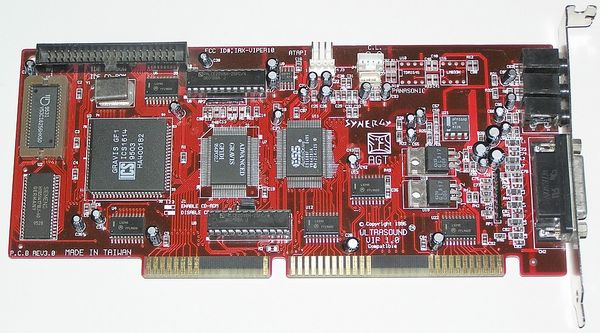(guest post from Frank Sapone)
A few months ago I made a guest-post about my personal experiences with the
Gravis UltraSound cards. In this article I mentioned there were a few variants
besides the standard GUS “Classic”, MAX, and PnP series. I was unable to
comment on the other cards since I did not own them. Well, that all changed
a few weeks ago when I contacted someone who wrote some pack-in software that
was included with most GUS cards and surprisingly he still had all his cards.
Even better, he was willing to give them to me!
One of the cards I received was the Synergy ViperMax. I have read some usenet
posts and have talked to other people who were active in the demoscene in the
mid-90s and apparently this card was originally designed by STB and then STB
produced their own card that has an ESS1688 chipset (for SB Pro compatibility
and better Windows drivers) and the GF1 chipset (the IC that makes the GUS
it’s own). How true is this story? I have no clue, as I have never seen an
STB variant of this card, but I have seen STB GUS PnP (the AMD Interwave
version) as Compaq OEM clones for sale occasionally.
In any case, Synergy started producing this card and it’s kind of a rare
number. Again, rumours afloat, that the guy from Synergy was coming to
demoparties and giving these away to groups that won competitions in an
effort to stir up some interest/sales. And before Advanced Gravis all but
gave up on the sound card market they took the Synergy ViperMax cards and
simply placed stickers over the Synergy logo and card name. Gravis also maxed
out the onboard RAM to 1MB (the ViperMax comes with 512kb by default). It is
exactly the same board, which leads me to believe Gravis may have purchased
remaining stock of the Synergy cards and unloaded them. The UltraSound Extreme
may be even more rare than the ViperMax. It’s hard to say as I have personally
never seen either of these cards for sale on ebay.
Keeping the GUS roots, the card is almost completely plug and play. The only
thing you must change is a jumper for CD-ROM Enable/Disable. Like the GUS MAX
there is CD-ROM interface support. Contrary to rumours, this card is NOT GUS
MAX compatible! It does not contain the Crystal CS4231 CODEC chip or emulate
it. This means no MAXSBOS and no special demos that will output 48khz (I only
know of one, The Secret Live of Mr. Black by Orange). I feel this
misinformation was started because of the CD-ROM interface that was also unique
to the GUS MAX. To setup your card you just run viprinit in DOS with your
appropriate SET BLASTER and SET ULTRASND variables and it configures the rest.
However, I noticed viprinit will not properly change your base address for the
ESS chipset (i.e. you want to change it from A220 to something else). No fear,
Synergy included the ESSCFG.EXE utility as well allowing you to change the
base address. Initial configuration is set with VSETUP.EXE from DOS.
Windows 95 installation is basically the same as the earlier cards. You
run the setup.exe and it will install the ESS drivers. It tries to setup
some extra stuff for UltraSound as MIDI device. And it does work just fine
but a gotcha is that the DOS stuff will break. I never had a reason to use
GUS’ MIDI capabilities from within Windows so this wasn’t a deal breaker
for me. After a reboot you will likely have to reconfigure your card
manually from the device manager but after that it’s smooth sailing. And yes,
you can install the updated ESS1688 drivers with no ill-effects. However,
if there are any differences in performance I have yet to notice it. Last known
official ESS drivers for Windows 9x at http://dk.toastednet.org/GUS/d
The ESS chip is really nice, it sounds very similar to the OPL3 and it has
SB PRO compatibility (take THAT SB16!). Whats the difference? The SB16 only
states that it’s Sound Blaster compatible, not Sound Blaster PRO compatible.
This means some earlier titles like Wolfenstein 3D will only output in mono
on the SB16. With the ViperMax, you can hear stereo sounds again.
Someone asked me if SBOS and MegaEm work. SBOS, no. MegaEm, yes but with no SB emulation. You can probably make MegaEm work with the SB emulation if you
want to play around with running ESSCFG, changing your PnP settings, updating
your BLASTER and ULTRASND variables then running viprinit. But, you’ll need
a lot of free resources and quite frankly I fail to see a point. If anyone
out there has pulled it off drop me a comment.
Since the card has a GF1 IC there is no comparision between the earlier GUS
cards. They will all sound the same. The signal-to-noise ratio is acceptable
though I haven’t measured what it truly is, but for gaming and watching some
demos it’s capable.
All in all, this is a great card. If it was released earlier and through
Advanced Gravis they could have still been in the market. Another nice
side effect of this card is that Windows XP has ESS1688 drivers. Just install
the cards as a non-pnp legacy device, configure manually and enjoy sound!
I made a few more rips comparing the differences between the ESS mode and GUS.
The few module files are played with XTC-Play and two of them (ATBIA3 and
Parallel Universe) are XM modules over 1MB. XTC-Play has a way of quadrupling
the RAM usage by downsampling. However, the modules still sound quite good
and it’s quite a thing to hear the GUS playing large high-quality modules.
Before I bring this article to a close, here is some ViperMax/GUS Extreme
Resources:
* Gravis UltraSound Extreme Manual: http://dk.toastednet.org/GUS/d
* Gravis UltraSound Extreme CD ISO: http://dk.toastednet.org/GUS/I
* Synergy ViperMax CD ISO: http://dk.toastednet.org/GUS/I
Enjoy the rips! In a few weeks I’ll have a write up on the Gravis UltraSound
Plug and Play Pro (waiting for my RAM upgrade) and finally some last minute
thoughts and information about a few other OEM cards and the GUS ACE.
For comparison here is DOOM II Map 06
Gravis
Sound Blaster



